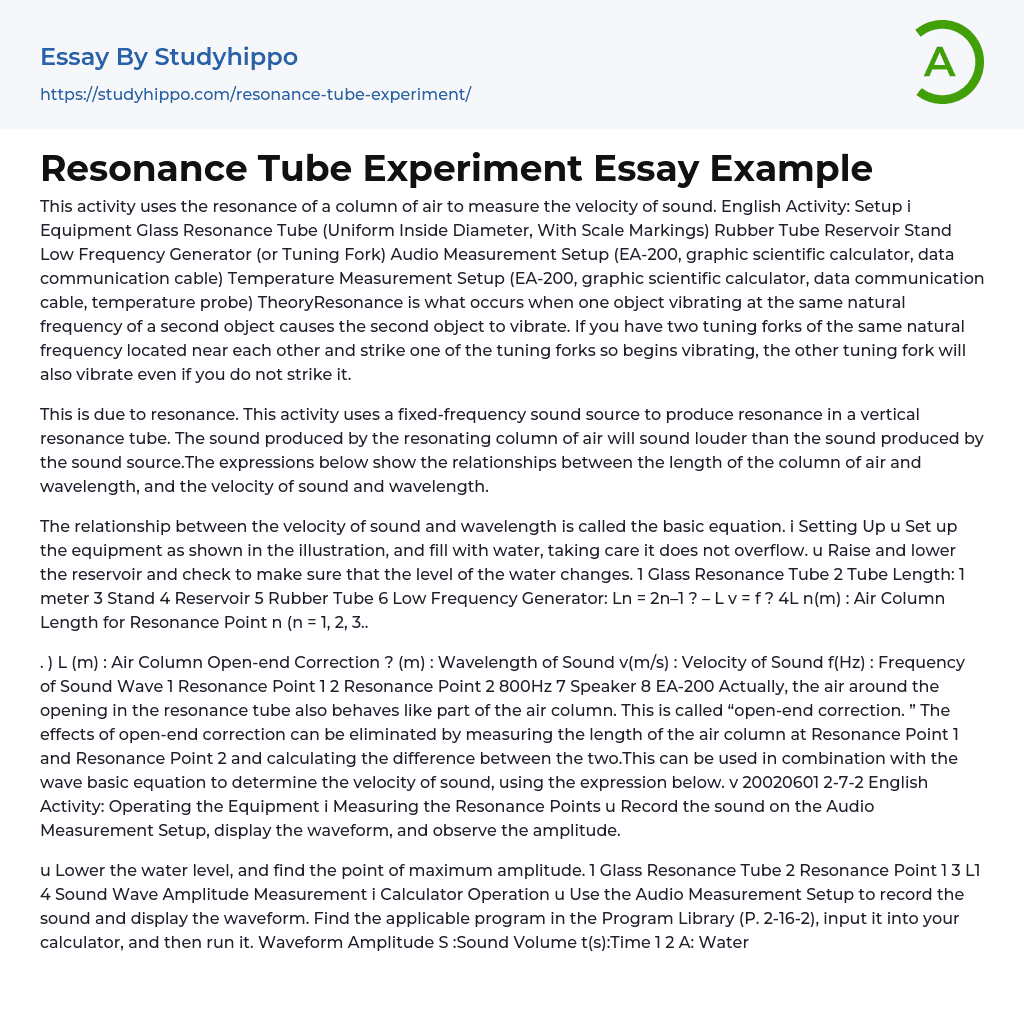This activity uses the resonance of a column of air to measure the velocity of sound. English Activity: Setup i Equipment Glass Resonance Tube (Uniform Inside Diameter, With Scale Markings) Rubber Tube Reservoir Stand Low Frequency Generator (or Tuning Fork) Audio Measurement Setup (EA-200, graphic scientific calculator, data communication cable) Temperature Measurement Setup (EA-200, graphic scientific calculator, data communication cable, temperature probe) TheoryResonance is what occurs when one object vibrating at the same natural frequency of a second object causes the second object to vibrate. If you have two tuning forks of the same natural frequency located near each other and strike one of the tuning forks so begins vibrating, the other tuning fork will also vibrate even if you do not strike it.
This is
...due to resonance. This activity uses a fixed-frequency sound source to produce resonance in a vertical resonance tube. The sound produced by the resonating column of air will sound louder than the sound produced by the sound source.The expressions below show the relationships between the length of the column of air and wavelength, and the velocity of sound and wavelength.
The relationship between the velocity of sound and wavelength is called the basic equation. i Setting Up u Set up the equipment as shown in the illustration, and fill with water, taking care it does not overflow. u Raise and lower the reservoir and check to make sure that the level of the water changes. 1 Glass Resonance Tube 2 Tube Length: 1 meter 3 Stand 4 Reservoir 5 Rubber Tube 6 Low Frequency Generator: Ln = 2n–1 ? – L v = f ? 4L n(m) : Ai
Column Length for Resonance Point n (n = 1, 2, 3..
. ) L (m) : Air Column Open-end Correction ? (m) : Wavelength of Sound v(m/s) : Velocity of Sound f(Hz) : Frequency of Sound Wave 1 Resonance Point 1 2 Resonance Point 2 800Hz 7 Speaker 8 EA-200 Actually, the air around the opening in the resonance tube also behaves like part of the air column. This is called “open-end correction. ” The effects of open-end correction can be eliminated by measuring the length of the air column at Resonance Point 1 and Resonance Point 2 and calculating the difference between the two.This can be used in combination with the wave basic equation to determine the velocity of sound, using the expression below. v 20020601 2-7-2 English Activity: Operating the Equipment i Measuring the Resonance Points u Record the sound on the Audio Measurement Setup, display the waveform, and observe the amplitude.
u Lower the water level, and find the point of maximum amplitude. 1 Glass Resonance Tube 2 Resonance Point 1 3 L1 4 Sound Wave Amplitude Measurement i Calculator Operation u Use the Audio Measurement Setup to record the sound and display the waveform. Find the applicable program in the Program Library (P. 2-16-2), input it into your calculator, and then run it. Waveform Amplitude S :Sound Volume t(s):Time 1 2 A: Water Level A B: Water Level B C: Water Level C u Lower the water level more, and find the next point of maximum amplitude. 1 Glass Resonance Tube 2 Resonance Point 1 3 L1 4 Resonance Point 2 5 L2 6 Sound Wave Amplitude Waveform at Water Levels A,
C, D, and F u Confirm that amplitude is at its maximum for water levels B and E.
D: Water Level D E: Water Level E F: Water Level F u Repeat the measurement three times and calculate the average of the results. u Substitute the average values of L1 and L2 into the theoretical expression and calculate the velocity of sound. Waveform at Water Levels B and E u Use the temperature probe to measure the temperature and then display it. u Find the applicable program (Charles’ Law) in the Program Library (P. 2-16-1), input it into your calculator, and then run it. i Measuring the Temperature of the Air Column Use the Temperature Measurement Setup to measure the temperature and then display it.
u Substitute the measured temperature values into the expression and calculate the velocity of sound. Next, compare the results with the previously obtained value. Other Things To Do 55555555555555555555555 5555555555 5555555555 uRepeat the experiment using a different frequency, and compare the difference in resonance points and sound velocity. u Use FFT analysis to determine the frequency at each water level, and compare the results with the sound source frequency. Substitute the observed velocity into the theoretical formula and calculate the openend correction value.
u Investigate what you need to multiply the open-end correction value in order to obtain the inside diameter of the resonance tube. u Perform the activity with a glass tube of a different diameter and find out how the open-end correction value is affected. v = 331. 5 + 0.
61T v(m/s) : Velocity of Sound T (°C) : Air Column Temperature 1 Glass Resonance Tube 2 Temperature
Probe (CH1) 3 EA-200 20020601 5555555555555555555555
- Experiment essays
- Explorer essays
- Hypothesis essays
- Observation essays
- Qualitative Research essays
- Research Methods essays
- Theory essays
- Automobile essays
- Bus essays
- Civil engineering essays
- Cycling essays
- Electric Car essays
- Genetic Engineering essays
- Hybrid essays
- Innovation essays
- Internal Combustion Engine essays
- Invention essays
- Mechanical Engineering essays
- Mechanics essays
- Software Engineering essays
- Telephone essays
- Atom essays
- Big Bang Theory essays
- Density essays
- Electricity essays
- Energy essays
- Force essays
- Heat essays
- Light essays
- Motion essays
- Nuclear Power essays
- Physiology essays
- Sound essays
- Speed essays
- Temperature essays
- Thermodynamics essays




